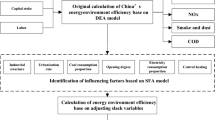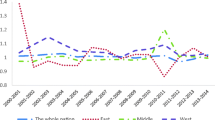Abstract
Using a sample of 14 prefecture-level cities in Liaoning Province, this study first explored the spatial hierarchy and structural characteristics of energy efficiency from the following three viewpoints: energy technical efficiency based on data envelopment analysis, energy consumption per unit of GDP, and energy utilization efficiency combining the previous two indexes. After measuring and analyzing the advancement, rationality, and concentration of the industrial structure in each city, we made some generalizations about the coupling features of the energy efficiency and industrial structure in Liaoning, using the coupling degree rating model. Some of our conclusions are as follows: (1) The 14 cities differ significantly in their energy efficiency, with Shenyang, Dalian, Anshan, and Jinzhou enjoying the highest energy efficiency. Northwestern Liaoning and other heavy-industrial cities such as Fushun and Benxi belong to low-efficiency and high-consumption areas. (2) In areas with higher efficiency, the spatial patterns of the energy technical efficiency, energy consumption per unit of GDP, and energy utilization efficiency are, respectively, “π”-, “II” — and “H”- shaped. Geographically, the energy utilization efficiency shows different trends from east to west and from north to south. Factors such as the binuclear structure of economic development have a major effect on this spatial pattern of energy efficiency. (3) Southeastern Liaoning enjoys a highly advanced industrial structure. Areas with a highly rational industrial structure form an “H” shape, with Shenyang and Dalian at the two poles. The urban agglomerations in middle and southern Liaoning have a highly concentrated industrial structure. (4) Overall, the coupling between energy efficiency and industrial structure is low in Liaoning, except for Shenyang and Dalian at both ends, where the coupling between an advanced industrial structure and energy efficiency is higher than in other cities.
Similar content being viewed by others
References
Boyd G A, Pang J X, 2000. Estimating the link-age between energy efficiency and productivity. Energy Policy, 28(5): 289–296.
Dang Yaoguo, Liu Sifeng, Wang Qingfeng et al., 2011. Theory and Practice of the Regional Industrial Structure Optimization. Beijing: Science Press, 39–48. (in Chinese)
Fan Fei, Du Debin, Wang Xinzhou, 2014. The measure and characteristics of spatial-temporal evolution of China’s science and technology resource allocation efficiency. Journal of Geographical Sciences, 24(3): 492–508.
Guan Wei, Guo Jiajing, Zhou Xintong, 2012. Evaluation on logistics industry development in the central cities of Northeast China based on principal component analysis. Journal of Liaoning Normal University: Natural Science Edition, 35(2): 252–258. (in Chinese)
Guan Wei, Zhu Haifei, 2011. Temporal-spatial analysis of inter-country economic differences in Liaoning province based on ESDA. Geographical Research, 30(11): 2008–2016. (in Chinese)
He Canfei, Wang Junsong, 2009. Economic transition and energy intensity in China. Scientia Geographica Sinica, 29(4): 461–469. (in Chinese)
Hu J L, Wang S C, 2006. Total-factor energy efficiency of regions in China. Energy Policy, 34(17): 3206–3217.
Li Xiaojian, 2006. Economic Geography. Beijing: Higher Education Press, 173–190. (in Chinese)
Li Xinzhan, Song Hemin, Zheng Xin, 2012. The rationalization analysis of industrial structure of Liaoning province based on deviation degree model. Journal of Shenyang University of Technology, 31(2): 35–37. (in Chinese)
Liang Liutao, Yang Jiantao, 2012. Analysis of the tourism efficiency and its decomposition based on DEA. Geographical Research, 31(8): 1422–1430. (in Chinese)
Liu Fengchao, Yang Ling, Zhao Chenhao, 2011. The spatial structure analysis of the economic development in Liaoning province: The measurement on the GIS platform. Journal of Dalian University of Technology: Social Sciences, 32(3): 1–5. (in Chinese)
Lu Dadao, 2001. An analysis of spatial structure and optimal regional development. Acta Geographica Sinica, 56(2): 127–134. (in Chinese)
Ma Li, Jin Fengjun, Liu Yi, 2012. Spatial pattern and industrial sector structure analysis on the coupling and coordinating degree of regional economic development and environment pollution in China. Acta Geographica Sinica, 67(10): 1299–1307. (in Chinese)
Qu Xiao’e, 2009. An analysis on Chinese inter-provincial differences in energy efficiency and their determinations. Economic Theory and Business Management, (2): 46–52. (in Chinese)
Wang Qiang, Zheng Ying, Wu Shidai et al., 2011. Mechanism of energy efficiency response to industrial restructuring and energy consumption structure change. Acta Geographica Sinica, 66(6): 741–749. (in Chinese)
Wang Yang, Zhao Wanmin, Guo Yue, 2007. Measuring regional economical non-balanced status based on geo-info technology: A case study of Chongqing. China Soft Science, (9): 61–68. (in Chinese)
Wei Chu, Shen Manhong, 2007. Energy efficiency and energy productivity: A comparison based on the panel data by province. The Journal of Quantitative & Technical Economics, (9): 110–121. (in Chinese)
Wei Chu, Shen Manhong, 2007. Energy efficiency and its influencing factor: Based on the positive analysis of DEA. Management World, (8): 66–76. (in Chinese)
Wei Quanling, 2000. Date envelopment analysis. Chinese Science Bulletin, 49(17): 1793–1808. (in Chinese)
Wei Quanling, 2012. Data Envelopment Analysis Models for Estimating Relative Efficiency-DEA and Network DEA. Beijing: China Renmin University Press, 1–6. (in Chinese)
Wei Yiming, Liao Hua, 2010. Seven energy efficiency indicators and their measurement approaches. China Soft Science, (1): 128–137. (in Chinese)
Zhang Jun, Wu Guiying, Zhang Jipeng, 2004. The estimation of China’s provincial capital stock: 1952–2000. Economic Research, (10): 35–44. (in Chinese)
Zhang Xiaoping, 2005. Temporal-spatial characteristics of energy consumption in China and its determination since the 1990s. China Population, Resources and Environment, 15(2): 38–41. (in Chinese)
Zhang Zhao, Wang Pin, Chen Yi et al., 2014. Spatial pattern and decadal change of agro-meteorological disasters in the main wheat production area of China during 1991–2009. Journal of Geographical Sciences, 24(3): 387–396.
Zhao Yuan, Hao Lisha, Yang Zuying, 2010. Regional differentiation of energy efficiency and its causes in Jiangsu. Acta Geographica Sinica, 65(8): 920–927. (in Chinese)
Zheng Shaozhi, Chen Zhihui, 2011. An empirical study on industry structure and economic growth-based on the analysis of China, Guangdong and Guangzhou. Industrial Economic Review, (5): 55–60. (in Chinese)
Author information
Authors and Affiliations
Corresponding author
Additional information
Foundation: The MOE Project of Key Research Institute of Humanities and Social Sciences in University, No.14JJD790044; Science and Technology Research Program Supported by the Education Department of Liaoning Province, No.L2013411
Author: Guan Wei (1959–), Professor, specialized in regional economy and industrial planning.
Rights and permissions
About this article
Cite this article
Guan, W., Xu, S. Spatial energy efficiency patterns and the coupling relationship with industrial structure: A study on Liaoning Province, China. J. Geogr. Sci. 25, 355–368 (2015). https://doi.org/10.1007/s11442-015-1173-z
Received:
Accepted:
Published:
Issue Date:
DOI: https://doi.org/10.1007/s11442-015-1173-z




